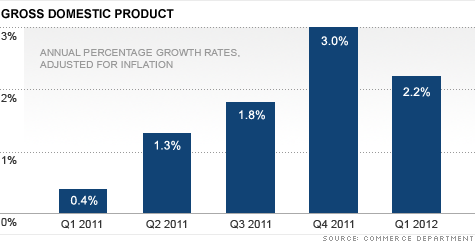Search News

NEW YORK (CNNMoney) -- The American economy grew slower than predicted in the first quarter, as government spending cuts offset a pickup in consumer spending.
Gross domestic product, the broadest measure of the nation's economy, grew at a 2.2% annual rate in the first three months of 2012, the Commerce Department said Friday, down from a 3% growth rate in the prior quarter.
Growth at that rate is considered too weak to lead to the hiring needed to put millions of unemployed Americans back to work.
The data was also lower than the 2.5% rate economists had been expecting.
The first quarter was largely characterized by consistently stronger retail sales but otherwise fickle economic data.
Job growth started off robust in January, but then faltered in March. Home construction increased at the beginning of the year, but then slumped. Inflation had been picking up earlier in the year amid rapidly rising gas prices, but has since moderated.
Meanwhile, consumer spending increased 2.9%. Spending was particularly robust on long lasting items like autos, with durable goods spending rising 15.3% in the quarter.
The fluctuation in the data, however, has led many economists to believe the mild winter gave the economy only a temporary boost at the beginning of the year.
For example, auto sales may have been unusually strong in January and February, simply because of warmer temperatures.
"More shoppers may have been walking the auto lots because they weren't covered in snow," said Beata Caranci, deputy chief economist at TD Economics.
The biggest drag on the economy came from government spending cuts. Spending by the federal government declined 5.6% driven primarily by defense cuts, while spending by state and local governments fell 1.2%.
It marked the sixth consecutive quarter that government cuts have weighed on GDP -- the likes of which have not been seen since 1953, when the United States was pulling out of the Korean War.
That streak is not expected to end anytime soon, especially as the economy nears a "fiscal cliff" in 2013. The Bush tax cuts, payroll tax cut and extended unemployment benefits are all set to end, at the same time that the government slashes more spending.
"We're going to see government cuts for the next couple quarters, and we don't even know what to expect on that front next year," Caranci said.
Even the Federal Reserve is erring on the side of caution given mixed economic data lately. In a press conference earlier this week, Fed Chairman Ben Bernanke said the fiscal cliff poses "significant risk to the recovery."
"If no action were to be taken by the fiscal authorities, the size of the fiscal cliff is such that, there's absolutely no chance the Federal Reserve could, or would have any ability whatsoever to offset that effect on the economy," he said.
The central bank predicts the economy will grow only 2.4% to 2.9% for the year overall.
But still, the U.S. economy sits in stark contrast to recessions in the United Kingdom and the euro zone.
"The U.S. economy remains a bright light in the global economy, although the light is hardly blinding, and also showing some signs of fading," said Chris Williamson, chief economist for Markit.
Friday's number is the Commerce Department's first estimate of first quarter GDP. As more data are collected, the government will revise the figures twice in the next couple months. ![]()
| Overnight Avg Rate | Latest | Change | Last Week |
|---|---|---|---|
| 30 yr fixed | 3.80% | 3.88% | |
| 15 yr fixed | 3.20% | 3.23% | |
| 5/1 ARM | 3.84% | 3.88% | |
| 30 yr refi | 3.82% | 3.93% | |
| 15 yr refi | 3.20% | 3.23% |
Today's featured rates:
| Latest Report | Next Update |
|---|---|
| Home prices | Aug 28 |
| Consumer confidence | Aug 28 |
| GDP | Aug 29 |
| Manufacturing (ISM) | Sept 4 |
| Jobs | Sept 7 |
| Inflation (CPI) | Sept 14 |
| Retail sales | Sept 14 |